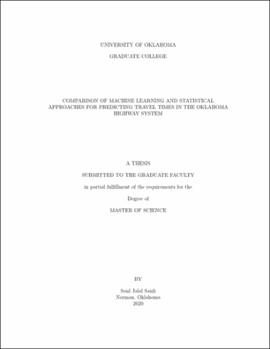| dc.description.abstract | Traffic management systems play a vital role in supporting the smooth flow of traffic in road networks. By accurately predicting travel time, a traffic condition parameter that is extensively used in such systems, we can significantly improve the efficiency of these systems, decision-makers, and travelers. In this work, we use a dataset from the Oklahoma Department of Transportation to compare the accuracy of statistical and machine learning approaches to predicting travel time.
We establish baseline accuracy by constructing a traditional statistical model using the seasonal autoregressive integrated moving average (SARIMA) approach. We compare this baseline to two machine learning models: one-dimensional convolutional neural networks (1-D CNNs) and long short-term memory (LSTM) networks. Our results show that our 1-D CNN and LSTM models have better performance than the statistical model. As an example, in a 4-step architecture (a model structure that simultaneously predicts travel time four periods ahead), the median root means squared relative error (RMSRE) scores for our LSTM and 1-D CNN models are 0.060 and 0.063, respectively. These compare to the median RMSRE score of 0.12 for the corresponding 4-step SARIMA model. The results also indicate that the machine learning approaches have significantly lower computation time compared to SARIMA. In addition, the 1-D CNN model has the least error variance across all architectures and among all modeling methods. Finally, the 1-D CNN approach is more consistent in terms of prediction error across the experimented architectures compared to the LSTM appraoch. Therefore, based on the results, we highly recommend using machine learning approaches, specifically, 1-D CNNs, for estimating travel time in roadway systems and for other similar time-series prediction problems. | en_US |
